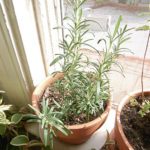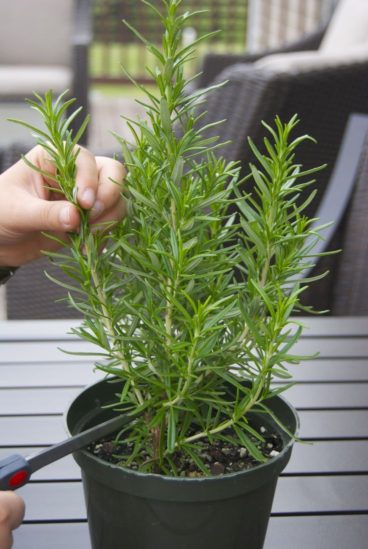 Most herbs taste much better fresh, and rosemary is no exception. That’s why every winter I try to keep my rosemary alive in a pot inside the house. Rosemary really pairs well with roasted lamb, garlic, and olive oil. It is also a nice addition to potatoes, bread, tomato sauce, pizza, and pork, but you might want to use a light hand because the flavor can be strong.
Most herbs taste much better fresh, and rosemary is no exception. That’s why every winter I try to keep my rosemary alive in a pot inside the house. Rosemary really pairs well with roasted lamb, garlic, and olive oil. It is also a nice addition to potatoes, bread, tomato sauce, pizza, and pork, but you might want to use a light hand because the flavor can be strong.
Rosemary does best in a sunny, southern or possibly western window, where the temperature is fairly cool. I keep the thermostat at 65°F during the day and 63°F at night. Your rosemary plant should be getting at least 6-8 hours of light a day. Be sure to rotate the plant every few days so every side gets a little bit of time in the sun.
Be careful not to over-water. Watering too often can cause root rot, which will kill the plant. Only water the soil when the top of the soil is dry to the touch. But, that being said, never let the soil dry out completely. I have discovered that if I keep my rosemary from totally drying out, it is more likely to survive. I usually water it every two weeks.
The most common problem for rosemary is powdery mildew, which typically affects plants that are too wet or have insufficient light and/or circulation. Stagnant air can allow mold and mildew spores to settle on plant leaves. If this seems to be a problem, you could use a small fan for a few hours daily to improve the air circulation.
Because rosemary is an edible plant, you have to be careful what you use to treat powdery mildew . When you first see signs of it, remove all affected parts of the plant (carefully, so as not to spread the mildew) and seal up the infected branches in airtight bags, then dispose of them.
Since rosemary is an herb and it is usually grown to be eaten, look for organic pesticides. The most popular is Neem oil, as it is very effective against pests but is completely harmless to humans and pets. Be sure to test on a few leaves first before treating the whole plant.


